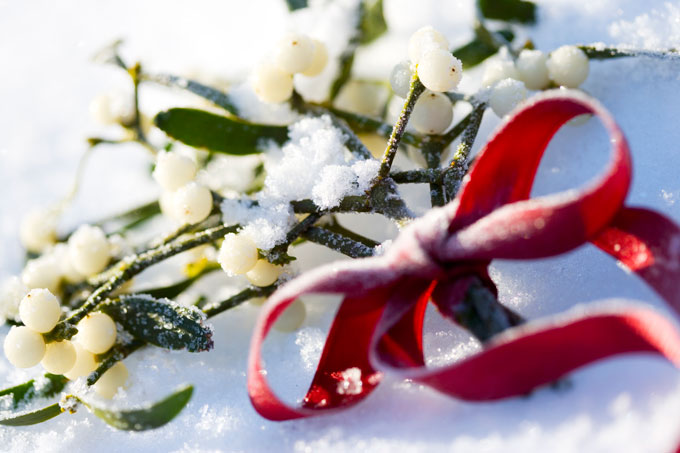From pagan symbol to religious custom and seasonal Victorian tradition, the mistletoe plant is now synonymous with British Christmas festivities
Mistletoe, a poisonous plant identified by its clusters of waxy white berries, is steeped in British folklore; indeed its very name comes from the Old English ‘mistletan’ meaning ‘special twig’. Usually found living as a partial parasite in the high boughs of deciduous trees, notably apple trees, it is commonly seen in cider country – Somerset, Gloucestershire, Worcestershire – and it is the county flower of Herefordshire. In Cornish tradition it is said that mistletoe was originally a fine tree itself and furnished the wood for Christ’s cross, after which it was condemned to live as a parasite.

Since the 18th century mistletoe has been a symbol of ongoing life through winter and used as a popular British Christmas decoration known as a ‘kissing ball’ – a ball of mistletoe, other evergreens, ribbons and tiny ornaments. In Victorian times, any girl walking under the mistletoe could not refuse a kiss, which was seen as a symbol of light-hearted romance or as an unofficial declaration of engagement.
Some people would take down the mistletoe decorations on the festival of Candlemas, or otherwise it was said all the boys and girls who kissed under it would be doomed never to marry (though the more recent tradition is for it to be brought down on the 12th day of Christmas). Other people would leave their mistletoe hanging until the following Christmas Eve to protect the house from fire.
But these Victorian customs hark all the way back to the pagan rituals of the ancient druids; according to the Roman philosopher, Pliny the elder, druids worshipped the mistletoe of the sacred oak. Following the winter solstice, five days after the new moon, priests robed in white would cut the mistletoe with a golden sickle, careful not to let it drop to the ground. Two white bulls would be sacrificed amid prayers, and sprigs would be hung over doorways and windows to provide protection from evil spirits. The plant was believed to cure ailments and act as a poison antidote, and it was a symbol of love and fertility as well as peace and goodwill – when enemies passed beneath it, a truce would be called until the following day.
Yet another story says the kissing tradition stems from Norse paganism. Myth has it that Frigg, goddess of marriage, loved her son Baldr so much she persuaded the four elements to promise her that no harm would come to him. But the evil spirit Loki killed Baldr with an arrow made of the one wood that grew neither on nor below earth – mistletoe. Frigg’s tears became the pearly white berries of the plant, and when her love restored Baldr’s life she reversed mistletoe’s lowly reputation, decreeing that no harm should come to those who pass under the mistletoe tree, only a kiss.
In the city of York, mistletoe was once incorporated into a winter church service of forgiveness and repentance, and though it is largely rejected by Christianity today, mistletoe still decorates York Minster’s high altar at Christmas time.






 © 2024
© 2024